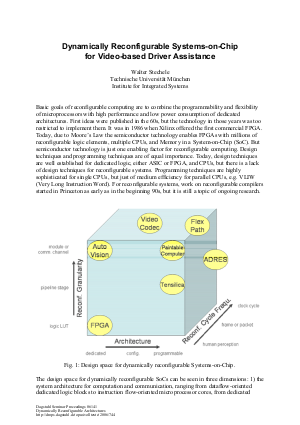Dynamically Reconfigurable Systems-on-Chip
Author Walter Stechele
-
Part of:
Volume:
Dagstuhl Seminar Proceedings, Volume 6141
Part of: Series: Dagstuhl Seminar Proceedings (DagSemProc) - License:
 Creative Commons Attribution 4.0 International license
Creative Commons Attribution 4.0 International license
- Publication Date: 2006-10-09
File

PDF
DagSemProc.06141.6.pdf
- Filesize: 1.34 MB
- 2 pages
Document Identifiers
Subject Classification
Keywords
- Dynamic reconfiguration
- design space
- video processing
Metrics
- Access Statistics
-
Total Accesses (updated on a weekly basis)
0Document
0Metadata
Abstract
The design space for dynamically reconfigurable SoCs can be seen in three dimensions: 1) the system architecture for computation and communication, ranging from dataflow-oriented dedicated logic blocks to instruction flow-oriented microprocessor cores, from dedicated point-to-point connections to Networks-on-Chip. 2) the granularity of reconfigurable elements, ranging from simple logic Look-Up-Tables to complex hardware accelerator engines and reconfigurable interconnect structures. 3) the configuration life cycle, ranging from application changes (in the order of seconds) to instruction-based reconfiguration (in the order of nanoseconds). We propose to use dynamically reconfigurable computing for video processing in driver assistance applications. In future automotive systems, video-based driver assistance will improve security. Video processing for driver assistance requires real time implementation of complex algorithms. A pure software implementation, based on low cost embedded CPUs in automotive environments, does not offer the required real time processing. Therefore hardware acceleration is necessary. Dedicated hardware circuits (ASICs) can offer the required real time processing, but they do not offer the necessary flexibility. Specific driving conditions, e.g. highway, country side, urban traffic, tunnel, require specific optimized algorithms. Reconfigurable hardware offers high potential for real time video processing and adaptability to various driving conditions. Our system architecture consists of embedded CPU cores for high-level application code, dedicated hardware accelerator engines for low level pixel processing, and an application-specific memory system. The hardware accelerators and the memory system are dynamically reconfigurable, i.e. hardware accelerator engines can be exchanged during runtime, controlled by the application code on the CPU. The life cycle of a configuration depends on the change of driving conditions. A requirement on the reconfiguration time is given by the frame rate of the video signal, e.g. 40 msec for the exchange and relocation of new engines.
Cite As Get BibTex
Walter Stechele. Dynamically Reconfigurable Systems-on-Chip. In Dynamically Reconfigurable Architectures. Dagstuhl Seminar Proceedings, Volume 6141, p. 1, Schloss Dagstuhl – Leibniz-Zentrum für Informatik (2006)
https://doi.org/10.4230/DagSemProc.06141.6
BibTex
@InProceedings{stechele:DagSemProc.06141.6,
author = {Stechele, Walter},
title = {{Dynamically Reconfigurable Systems-on-Chip}},
booktitle = {Dynamically Reconfigurable Architectures},
pages = {1--1},
series = {Dagstuhl Seminar Proceedings (DagSemProc)},
ISSN = {1862-4405},
year = {2006},
volume = {6141},
editor = {Peter M. Athanas and J\"{u}rgen Becker and Gordon Brebner and J\"{u}rgen Teich},
publisher = {Schloss Dagstuhl -- Leibniz-Zentrum f{\"u}r Informatik},
address = {Dagstuhl, Germany},
URL = {https://drops.dagstuhl.de/entities/document/10.4230/DagSemProc.06141.6},
URN = {urn:nbn:de:0030-drops-7446},
doi = {10.4230/DagSemProc.06141.6},
annote = {Keywords: Dynamic reconfiguration, design space, video processing}
}
